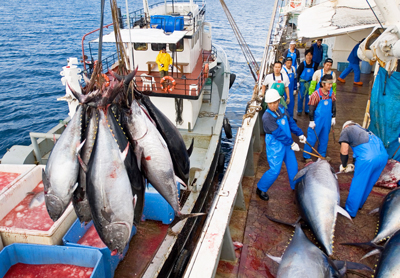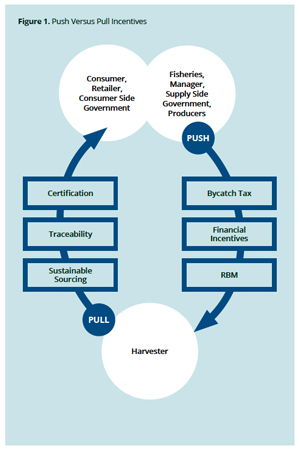Fisheries Governance in the Areas Beyond National Jurisdiction - the Essential Role of Incentives
22 February 2019
Fisheries that intersect with the areas beyond national jurisdictions (ABNJ) are ecologically, institutionally and politically complex. These fisheries contribute to enormous economic and social benefits and have the potential to generate even greater benefits and wealth under management regimes that incorporate incentives. The main international instruments for the ABNJ fisheries are the United Nations Convention on Law of the Sea (UNCLOS) and the UN Fish Stocks Agreement (UNFSA). Governance gaps within UNCLOS, UNFSA and other international legal instruments are well recognized.
 Blue-fin tuna harvest in Eastern Mediterranean, Turkey ©zaferkizilkaya |
While the need for incentives is critical to make up for the gaps in governance, the gaps themselves and the multilateral nature of ABNJ fisheries management make it hard to achieve first best solutions. Responding to the need to address these gaps, the Common Oceans ABNJ Program's Global Think Tank was tasked with developing a new theory of change for ABNJ fisheries.
It is clear that no single intervention that will solve the problem of ABNJ fisheries. This is a complex problem that can only be addressed with a smart mix of interventions. By segmenting the problem into manageable parts, sequencing the "right" mix of interventions that include incentives and scaling up over time, the larger ABNJ problem can be tackled. The nine principles discussed in this report can guide the application of smart mixes into the management of ABNJ fisheries. These design principles are a positive way forward in complex, adaptive systems where no single entity is in control and there is a critical need for change.
The Common Oceans ABNJ Program's Global Think Tank, an initiative carried out under the Common Oceans ABNJ Project on Ocean Partnerships, is comprised of a diverse group of experts on the tuna industry, but also fisheries financing, economics, international law, management of tuna fisheries, and ecology of highly migratory fisheries. Together with partner organization the World Wildlife Fund (WWF), they produced a publication on Principles for Fisheries Management in Areas Beyond National Jurisdiction – the Essential Role of Incentive-Based Approaches, based on lessons learned from regional business cases and two supporting technical reports. These technical reports covered topics such as applicable legal instruments, relevant institutions, incentives and the performance of innovative programs in the convention areas of the five tuna regional fisheries management bodies (RFMOs).
Incentive Based Approaches
 |
Incentive-based approaches are dependent on identifying which entity/ies (States, RFMOs, consumers, or fishers) to incentivize. Defining the incentives into two broad groups, "push" and "pull," highlights mechanisms of how they work (see figure 1).
Pull incentives are based on buyer demand for products with a verifiable claim of sustainable or responsibly-produced seafood. These instruments include sustainable sourcing commitments from retailers and consumer-facing certification schemes, such as the Marine Stewardship Council that seek to engage buyer purchasing practices.
Push incentives focus directly on the production side of the seafood supply chain. These incentive-based interventions include, but are not limited to, financial incentives, bycatch taxes and environmental credit systems, Coasian bargaining, and rights-based management. Push incentives directly impact the operating margin of harvesters and/or the value generated for States leasing access rights.
Push incentives are different than pull incentives, but remain related in the sense that they both aim to influence the behavior of producers and/or the formation and enforcement of (State) management and regulation.
Smart Mixes for Effective Governance of ABNJ
Given the highly contextual nature of management, any advice on developing and/or applying individual or combinations of incentive-based tools needs to be informed by clear, functional, and regulatory design principles. Drawing on the vast multi-disciplinary literature and insights from the GloTT, nine principles for utilizing ‘smart mixes' of regulatory and incentive-based tools (instruments) were developed bolstered by examples and case studies:
- Prefer instrument mixes incorporating compatible combinations.
- Calibrate interventions towards points of least resistance, lowest cost and maximum impact
- Sequence or scale interventions as necessary to achieve goals
- Empower participants to act as surrogate regulators and enable voluntary initiatives.
- Maximize opportunities for net gain outcomes
- Consider and harness the responsiveness of stakeholders (bottom up matters).
- Consider top-down relationships, opportunities and constraints
- Assess and adapt the smart mix in light of its effectiveness.
- Assess opportunities for better interventions.
Access the full publication and supporting in-depth documents here:
- Principles for Fisheries Management in Areas Beyond National Jurisdiction - the Essential Role of Incentive-Based Approaches
- Assessing the Application of Innovative Incentive-Based Tools to Reform Highly Migratory Fisheries from Regional to Global Scale
- Innovative Incentive-Based Tools in Reform of Highly Migratory Fisheries at Project Development and Regional Scales
The Common Oceans ABNJ Ocean Partnerships Project, funded by the Global Environment Facility and implemented by the World Bank, comprises four regional sub-projects aimed at designing pilot investments and activities for sustainable fisheries in the ABNJ, as well as an innovation support facility led by Conservation International, and the GloTT coordinated by the WWF.
For further information, please contact:
- Dr Vishwanie Maharaj – Lead Economist, Oceans, World Wildlife Fund-US | [email protected]
 |
 |
 |

